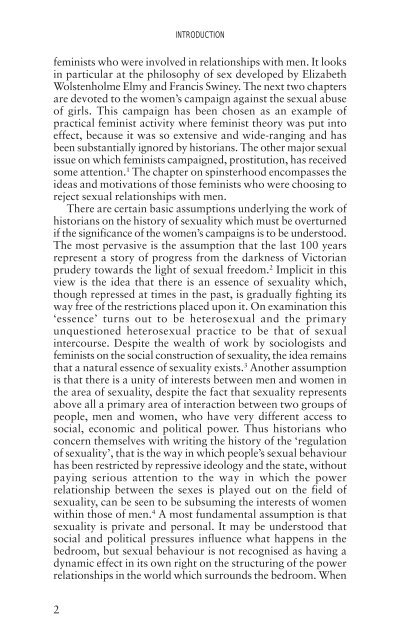The Spinster and Her Enemies - Feminish
The Spinster and Her Enemies - Feminish
The Spinster and Her Enemies - Feminish
You also want an ePaper? Increase the reach of your titles
YUMPU automatically turns print PDFs into web optimized ePapers that Google loves.
INTRODUCTION<br />
feminists who were involved in relationships with men. It looks<br />
in particular at the philosophy of sex developed by Elizabeth<br />
Wolstenholme Elmy <strong>and</strong> Francis Swiney. <strong>The</strong> next two chapters<br />
are devoted to the women’s campaign against the sexual abuse<br />
of girls. This campaign has been chosen as an example of<br />
practical feminist activity where feminist theory was put into<br />
effect, because it was so extensive <strong>and</strong> wide-ranging <strong>and</strong> has<br />
been substantially ignored by historians. <strong>The</strong> other major sexual<br />
issue on which feminists campaigned, prostitution, has received<br />
some attention. 1 <strong>The</strong> chapter on spinsterhood encompasses the<br />
ideas <strong>and</strong> motivations of those feminists who were choosing to<br />
reject sexual relationships with men.<br />
<strong>The</strong>re are certain basic assumptions underlying the work of<br />
historians on the history of sexuality which must be overturned<br />
if the significance of the women’s campaigns is to be understood.<br />
<strong>The</strong> most pervasive is the assumption that the last 100 years<br />
represent a story of progress from the darkness of Victorian<br />
prudery towards the light of sexual freedom. 2 Implicit in this<br />
view is the idea that there is an essence of sexuality which,<br />
though repressed at times in the past, is gradually fighting its<br />
way free of the restrictions placed upon it. On examination this<br />
‘essence’ turns out to be heterosexual <strong>and</strong> the primary<br />
unquestioned heterosexual practice to be that of sexual<br />
intercourse. Despite the wealth of work by sociologists <strong>and</strong><br />
feminists on the social construction of sexuality, the idea remains<br />
that a natural essence of sexuality exists. 3 Another assumption<br />
is that there is a unity of interests between men <strong>and</strong> women in<br />
the area of sexuality, despite the fact that sexuality represents<br />
above all a primary area of interaction between two groups of<br />
people, men <strong>and</strong> women, who have very different access to<br />
social, economic <strong>and</strong> political power. Thus historians who<br />
concern themselves with writing the history of the ‘regulation<br />
of sexuality’, that is the way in which people’s sexual behaviour<br />
has been restricted by repressive ideology <strong>and</strong> the state, without<br />
paying serious attention to the way in which the power<br />
relationship between the sexes is played out on the field of<br />
sexuality, can be seen to be subsuming the interests of women<br />
within those of men. 4 A most fundamental assumption is that<br />
sexuality is private <strong>and</strong> personal. It may be understood that<br />
social <strong>and</strong> political pressures influence what happens in the<br />
bedroom, but sexual behaviour is not recognised as having a<br />
dynamic effect in its own right on the structuring of the power<br />
relationships in the world which surrounds the bedroom. When<br />
2

















